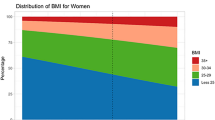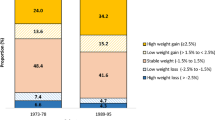Abstract
OBJECTIVE: To examine the rate of weight gain over time among Americans by age, gender, and race.
PARTICIPANTS: Scientific sample of 5117 Americans, ages 25–74?y in 1971 followed for 20?y.
RESULTS: Rates of weight gain estimated by mixed effects models are highest among young adults and rates of weight loss are greatest among older adults. The overall shape of the growth curves are similar for men and women, black and white, in terms of both weight gain and weight loss. Rates are also affected by baseline body mass index (BMI=wt in kg/height in m2).
CONCLUSIONS: Americans gain weight until middle age, stabilize, and begin to lose weight near age 60. Weight loss during old age is especially evident for obese Americans. The ability to accurately identify groups with increased risk and target them for obesity prevention will help combat the steady rise of overweight and obesity in America.
This is a preview of subscription content, access via your institution
Access options
Subscribe to this journal
Receive 12 print issues and online access
$259.00 per year
only $21.58 per issue
Buy this article
- Purchase on Springer Link
- Instant access to full article PDF
Prices may be subject to local taxes which are calculated during checkout


Similar content being viewed by others
References
Friedman JM . Obesity in the new millennium. Nature 2000; 404: 632–634.
Flegal KM, Carroll MD, Kuczmarski RJ, Johnson CL . Overweight and obesity in the United States: prevalence and trends, 1960–1994. Int J Obes Relat Metab Disord 1998; 22: 39–47.
Mueller WH, Wear ML, Hanis CL, Emerson JB, Barton SA, Hewwett-Emmett D, Schull WJ . Which measure of body fat distribution is best for epidemiologic research? Am J Epidemiol 1991; 133: 858–869.
Guo SS, Zeller C, Chumlea WC, Siervogel RM . Aging, body composition, and lifestyle: the Fels Longitudinal Study. Am J Clin Nutr 1999; 70: 405–411.
Chumlea WC, Guo SS, Zeller CM, Reo NV, Siervogel RM . Total body water data for white adults 18 to 64 years of age: the Fels Longitudinal Study. Kidney Int 1999; 56: 244–252.
Shimokata H, Andres R, Coon PJ, Elahi D, Muller DC, Tobin JD . Studies in the distribution of body fat. II. Longitudinal effects of change in weight. Int J Obes Relat Metab Disord 1989; 13: 455–464.
Williamson DF . Epidemiologic analysis of weight gain in US adults. Nutrition 1991; 7: 285–286.
Cornoni-Huntley JC, Harris TB, Everett DF, Albanes D, Micozzi MS, Miles TP, Feldman JJ . An overview of body weight of older persons, including the impact on mortality. The National Health and Nutrition Examination Survey I—epidemiologic follow-up study. J Clin Epidemiol 1991; 44: 743–753.
Allison DB, Fontaine KR, Manson JE, Stevens J, VanItallie TB . Annual deaths attributable to obesity in the United States. JAMA 1999; 282: 1530–1538.
Must A, Spadano J, Coakley EH, Field AE, Colditz G, Dietz WH . The disease burden associated with overweight and obesity. JAMA 1999; 282: 1523–1529.
Pinheiro JC, Bates DM . Mixed-Effects Models in S and S-PLUS. Springer: New York, 2000.
Draper NR, Smith H . Detection of influential observations. In: Bradley H, Kendall, Watson (eds). Applied regression analysis, 2nd edn. John Wiley and Sons: New York; 1981. pp 170–171.
Insightful. S-PLUS 6.0. Insightful Corp.: Seattle, WA; 1988–2001.
SAS Institute. SAS. 8.0. SAS Institute: Cary, NC; 1999.
Akaike H . A new look at the statistical model identification. IEEE Trans Automatic Control 1974; 19: 716–723.
SPSS Inc. SPSS Interactive Graphics. SPSS Inc.: Chicago, IL; 1999. p 161.
Kyle UG, Genton L, Hans D, Karsegard L, Slosman DO, Pichard C . Age-related differences in fat-free mass, skeletal muscle, body cell mass and fat mass between 18 and 94 years. Eur J Clin Nutr 2001; 55: 663–672.
Acknowledgements
This research was supported in part by grants from the Arthritis Foundation and the Claude Pepper Older Americans Independence Center. We thank Frank Davidoff, MD, Michelle Berlin, MD, MPH, and Judith Fifield, PhD for helpful comments on an earlier draft. We are also grateful for the helpful comments of the anonymous reviewers.
Author information
Authors and Affiliations
Corresponding author
Rights and permissions
About this article
Cite this article
Sheehan, T., DuBrava, S., DeChello, L. et al. Rates of weight change for black and white Americans over a twenty year period. Int J Obes 27, 498–504 (2003). https://doi.org/10.1038/sj.ijo.0802263
Received:
Revised:
Accepted:
Published:
Issue Date:
DOI: https://doi.org/10.1038/sj.ijo.0802263
Keywords
This article is cited by
-
Trends in weight change patterns across life course among US adults, 1988–2018: population-based study
BMC Public Health (2023)
-
Is being childless associated with a woman’s risk of overweight and obesity? Results from a national longitudinal study
International Journal of Obesity (2023)
-
Maternal weight and its association with risk of overweight in offspring: a trajectory analysis from a birth cohort in China
World Journal of Pediatrics (2023)
-
Dietary patterns and young adult body mass change: A 9-year longitudinal study
European Journal of Nutrition (2023)
-
Early adulthood weight change, midlife “Life’s essential 8” health status and risk of cardiometabolic diseases: a chinese nationwide cohort study
Nutrition & Metabolism (2023)



